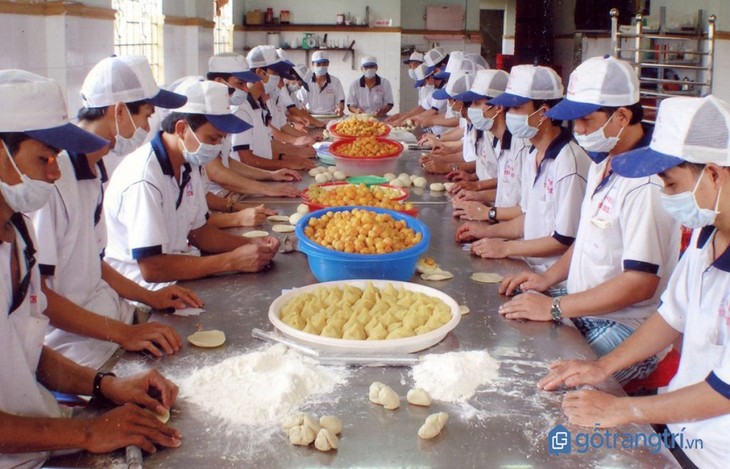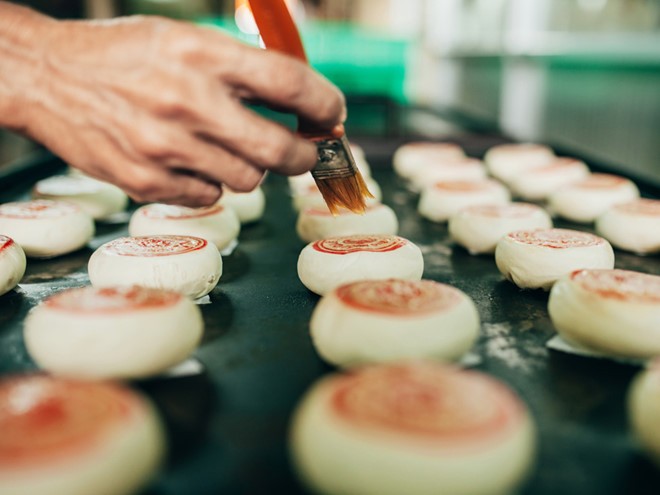(VOVWORLD) - Coming to Soc Trang province, tourists not only visit Khmer ethnic people’s ancient pagodas or take part in bustling festivals, but also enjoy specialties of the three local ethnic groups of Kinh, Chinese, and Khmer. Pia Cake – a specialty of the Chinese emigrating into the south - is one of the province’s signature dishes. The cake has crossed the national border to be available in a number of places around the world.
|
 Soc Trang has 50 Pia cake making establishments. Soc Trang has 50 Pia cake making establishments.
(Photo: thanhnien.vn)
|
In the 17th century, Pia cake was introduced to Soc Trang by the Chinese people who sought refuge in the South of Vietnam.
Doctor Trinh Cong Ly, Chairman of the provincial Association of Historical Sciences, touched upon the origin of Pia cake: “Vietnam’s Nguyen Lord allowed former generals of China’s Ming Dynasty to live in exile in the southern region. They were members of the Anti-Manchuism movements and uprisings and refused to give in to the Qing dynasty by running southward to reside. About 3,000 soldiers and their family members were arranged to settle in My Tho and Bien Hoa since 1786. They might set themselves up in business in Vung Thom and develop the craft to make Pia cakes.”
Vung Thom village in My Tu district is considered the center of Pia cake making. In the past the cake was only made during Mid-Autumn Festival and Lunar New Year Holiday.
Currently Soc Trang has 50 Pia cake making establishments. The materials include wheat flour, green beans, taro, durian, salted egg, and lotus seed. When making delicious Pia cakes, you will need to follow some complicated and skillful steps.
Flour is kneaded with water, white sugar, salt, cooking oil and pig fat to create the cover. To create a thin cover with many layers, the flour is processed in many ways, such as stirring the flour together, making it thin and then rolling it over. This is a key stage to make the Pia cake’s many layers of crust which is the most typical feature characteristics of this specialty.
It is not so easy to make the stuffing of Pia. It involves carefully mixing all the ingredients together to create the right flavor and attractive scent.
 Pia cakes in the making (Photo: thanhnien.vn) Pia cakes in the making (Photo: thanhnien.vn) |
Depending on each type of Pia, the cake stuffing will be made with different recipes. After steaming the green beans, sugar will be added then the mixure will be ground smoothly with some liquid lard added; the flesh of durian is separated, mixed with pig nape fat; and then cover with salted duck’s yolk. To make the cakes greasier, the maker can add pork to the stuffing.
Tran Can, the owner of Pia cake bakery in Chau Thanh district, said: “In the past, Pia cakes were made manually. On every the first or the fifteenth day of a lunar month, especially Mid-Autumn, Pia cake factories must increase shifts to meet the market demands.”
 One stepof the baking process (Photo: thanhnien.vn) One stepof the baking process (Photo: thanhnien.vn) |
Lap Hung Pia cake has been famous for 30 years for its quality stuffing and soft, multi-layered crust. The main flavor is the combination of durian fruit and steamed green beans.
Truong Minh Nghia, the owner of Lap Hung Pia Cake Company, said: “Pia cake is of Chinese people. I began to learn the craft 50 years ago. Each brand has its own flavor and secret. Cake makers’ experience and good ingredients will create high-quality Pia cakes.”
The packing of Pia cake boxes has remained the same for years. Although a 4-piece cylindrical box is still red and yellow in color, it looks more colorful and professional with detailed labels about materials, quality standards, production date, and expiry date now attached to the side of the boxes.